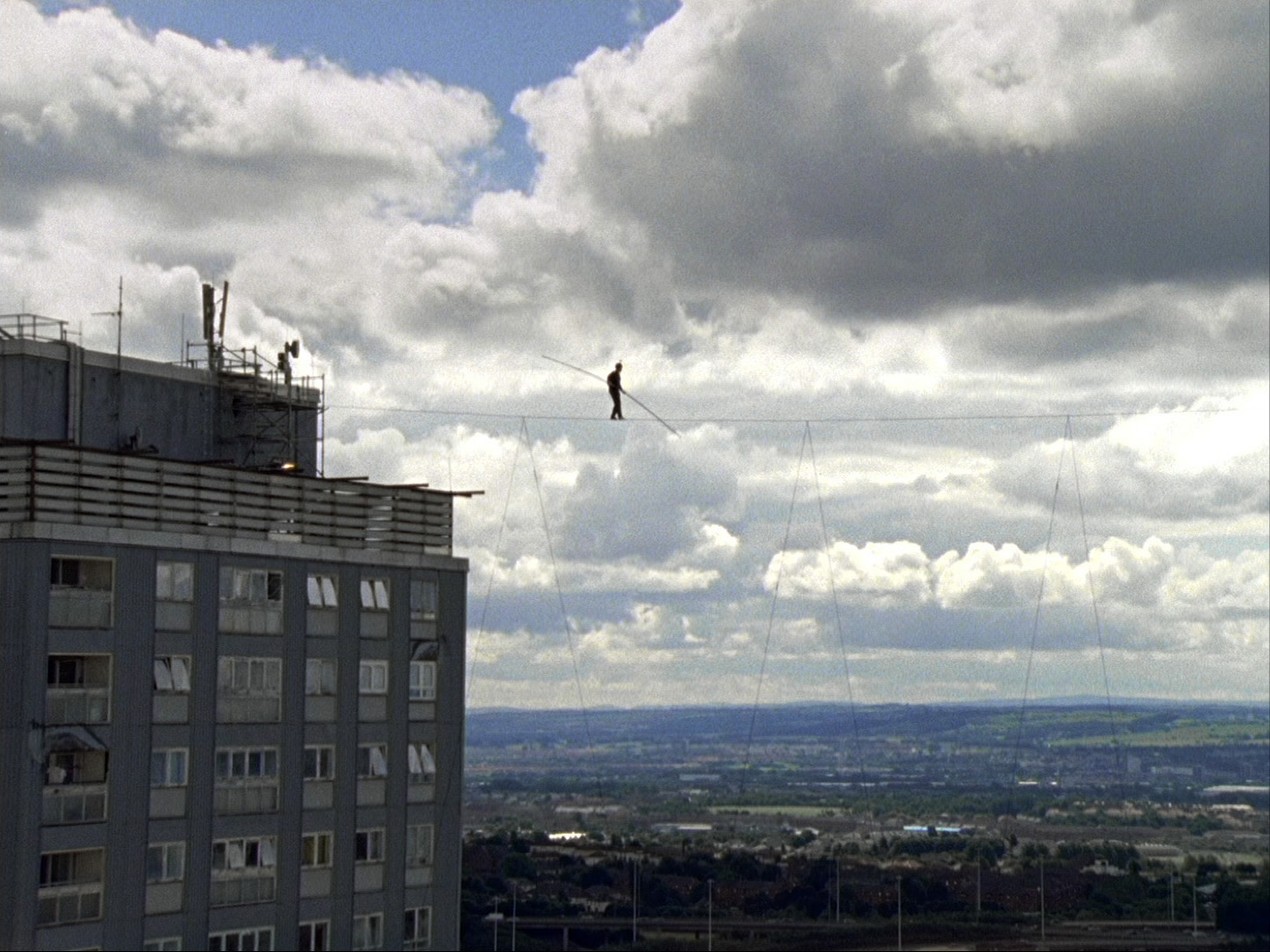


Through metal gates off the rumbling east-west artery of Marylebone Road, you descend concrete ramps past industrial plant and detritus. As a preparation for looking at art, it can’t be beaten. Ambika P3 is entered via a mezzanine level and, poised before plunging down the ringing steel staircase, one has a thrilling view, down into the cavernous main space. Originally built as a facility for testing concrete, it is used as an exhibition space by the University of Westminster, who have done nothing to soften its aesthetics.
Falling Away brings together eight moving image works from across the last twenty years of Catherine Yass’ career. Shown mostly as large-scale projections they inhabit the vast, bunker-like hall of Ambika as if they had been made especially for it. The exhibition offers an opportunity to appreciate the coherence of Yass’ concerns over many years, as well as the ambition, rigour and spectacular beauty of her image-making.
Five of the eight works were made in London, the artist’s home. Descent, 2002 was filmed in Canary Wharf, Aeolian Piano, 2017 at the old BBC TV Centre in Shepherds Bush, Royal London, 2018 at the hospital in Whitechapel, Last Stand, 2019 in Nine Elms and Concrete Mixer, 2021 in the further eastern reaches of London’s docklands. Through them, Yass offers a commentary on national institutions such as the BBC and the National Health Service. A focus on the nature of institutions, as expressed through their architecture, has been a constant since she first came to prominence in the 1990s. At the same time, through all of the London works, the relentless action of international finance and property speculation on the fabric of the city is an underlying narrative.
Last Stand, 2019 is the first work one encounters on entering the exhibition. A single, huge screen on the mezzanine, it is best viewed from down on the main floor. Looking up, we see a slight figure standing improbably atop the concrete core of a building under construction. The camera circles slowly, as the artist looks resolutely, or resignedly, out across the skyline of Nine Elms where glass towers of luxury flats were rising fast. The sense of her diminutive figure isolated in space and raised 12 stories above ground is awe-inspiring. She might be a sacrificial offering on a scaffold, or an urban counterpart to Caspar David Friedrich’s Wanderer above a sea of fog, 1818. There is no doubt that the artist is angry: angry about what she has called “the privatisation of the sky through selling it as real estate”. The speculative private developments of London contrast sharply with the Red Road social housing on the outskirts of Glasgow that features in High Wire, 2007: a product of the utopian 1960s vision to replace slums with houses in the sky.
All of the works here are technically ambitious in the way they were made, requiring cranes, helicopters and boats to achieve viewpoints that are beyond usual human capacity. Descent, 2002 is another single screen projection, a single vertical tracking shot lasting over eight minutes. The camera was attached upside down to a crane on a tower under construction at Canary Wharf so that the viewer is looking upwards as it travels down towards the ground, at first through dense fog, which slowly clears revealing more of the surroundings. The ostensible simplicity of the set-up recalls the iconic 1964 Empire State by Andy Warhol. But it also mimics, in slow motion, the view of a falling body.
Royal London, 2018 shares something of the close range of colours in Descent. Soft greys, blacks and pale, watery greens predominate in this elegiac pass through the hospital as it was undergoing partial demolition. Once again the viewpoint is descending: spiralling down from a skylight, down the ornate Victorian staircase and then through a series of treatment rooms, equipment mournfully piled in heaps. In the final sequence the camera looks on as building rubbish falls down through an opening to the sky – plastic sheeting twists and flutters gracefully as it falls. This may be a portrait of a London institution – the hospital was home to Joseph Merrick, the Elephant Man – but it is also a wider meditation on the current state of the NHS in England.
Taken as a whole, Falling Away creates a pervading sense of vertigo. Each work is in its way physically disorientating, insinuating a sense of peril that builds progressively. At the same time, the works suggest the destabilisation of some of the institutions that have defined the country since the Second World War, and the inexorable progress of free market economics. Astonishingly, the exhibition runs for only one month, so there are only a couple more weeks to see this brilliantly curated show of work that is complex and subtle in its discourse and visually breath-taking as an experience.
Caroline Douglas
Director
Ambika P3, 35 Marylebone Road, London NW1 5LS. Open Tuesday to Friday, 11.00–19.00, Saturday-Sunday, 12.00–18.00. Exhibition continues until 20 November 2021. www.p3exhibitions.com